Pathomation: Thoughts on Software Development Life Cycle (SDLC) – part 1
 What we do
What we do
At the end of the day, what we do is straightforward: Pathomation makes middleware software for digital pathology.
Now depending on who you talk to, one or more terms in that statement may take some explaining:
- Pathomation: it’s not phantomation (ghostbusters, anybody?), photomation (photonics, quantum physics; nah, to be honest we’re probably not smart enough)… It’s Pathomation, from Pathology – Automation.
- Middleware software: Middleware acts as a broker between different components. Your typical example of middleware would be a printer driver, which allows a user to convert text and pixels from the computer screen to ink on paper. On that note, “pixel broker”, is another way how we like to describe ourselves. The slide scanner converts the tissue from the glass slide into a (huge!) collection of pixels, and we make sure these pixels can be read and presented properly, regardless of what scanner was used to generate them, and regardless of where they are stored
- Digital pathology: it started in the 60s at Massachusetts General Hospital in Boston with tele-pathology. In the 2000s, engineers figured out that they could automate microscopes to take sequential pictures of various regions of interest on glass slides, and then stitch those to create (again: huge!) compound images that would let pathologists bypass the traditional microscope altogether and use the computer screen as a virtual microscope.
- Pathology: the medical sub-specialty that diagnoses disease at the smallest level. Up to 70% of therapeutic treatment is attributable to one pathological exam or another. That’s… huge actually, and it’s why it’s all the more important to make the pixels from the scan flow to that storage location to that computer screen as smooth as possible.
So there you have it: we make middleware software that optimizes the transport of pixels. We show the pathologist the pixels he or she needs, when he or she wants, where he or she desires to have them.
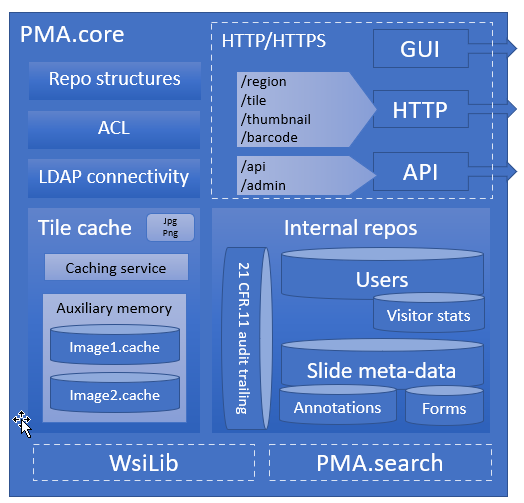
The central piece of software we develop for that is called PMA.core, and on top of PMA.core we have a variety of end-user front-end applications like PMA.slidebox, PMA.studio, or PMA.control.
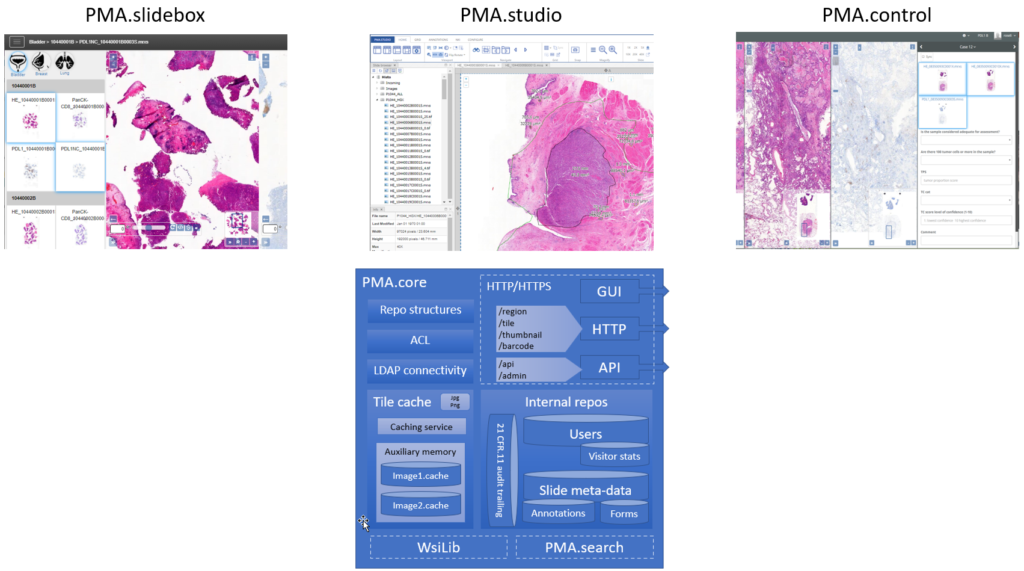
Growing software
We didn’t start off with these though. So bear with us as we take a little trip down memory lane.
Once you have a successful piece of software, it doesn’t take long for people to ask “hey, can I also use it for this (or that)?” Therefore, on top of PMA.core, we built several Software Development Kits (SDKs) that make it easier for other software developers to integrate digital pathology into their own applications (image analysis (AI/DL/ML), APLIS, LIMS, PACS…).
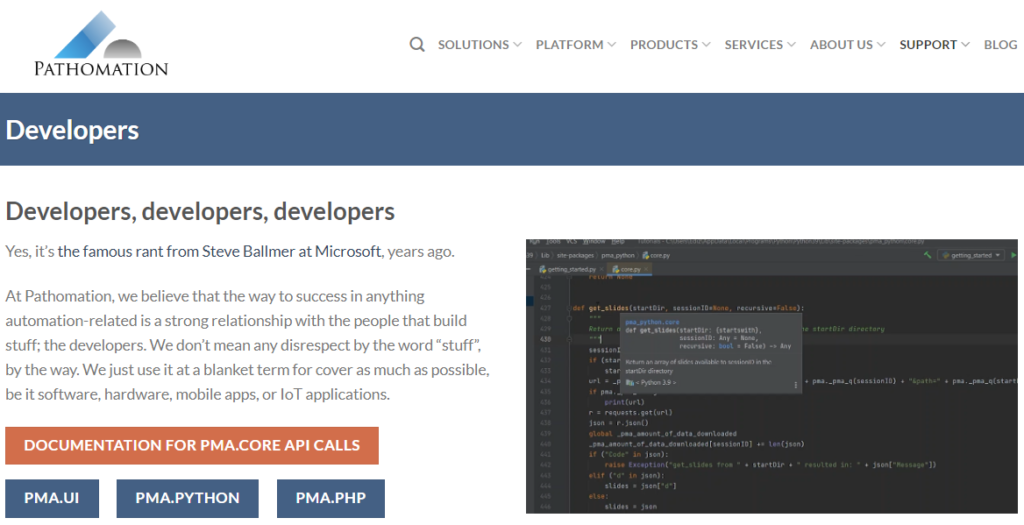
The next question is: “I don’t know how to program. I just have a WordPress blog that I want to embed some slides in.” So we wrote a series of plugins for various Content Management Systems (CMS), Learning Management Systems (LMS), and even third-party Image Analysis (IA) tools.
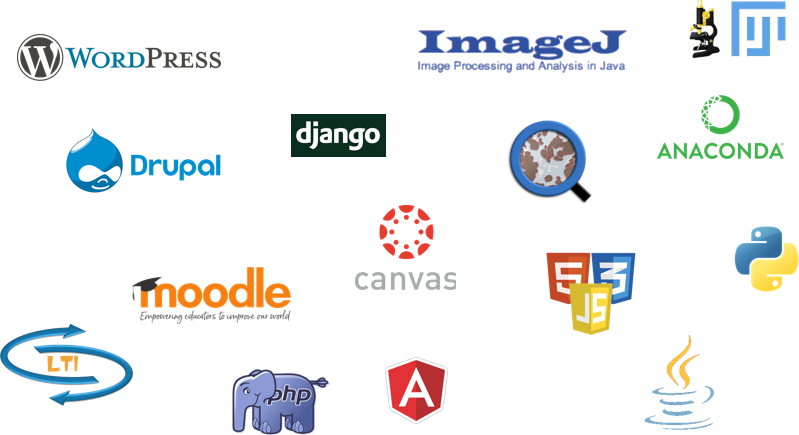
Eventually, we got into integrated end-user application development, too. As far as we’re concerned, we have three software packages that cater to end-users:
- PMA.slidebox caters to educational applications whereby people just want to share collections with students, conference participants, or peers. A journal could benefit from this and publish virtual slides via a slidebox to serve as supplemental material to go with select author papers.
- PMA.studio wants to be a pathologist’s cockpit. You can have slides presented in grid layouts, coming from different PMA.core servers. But if you’re an image analyst working with whole slide images (WSI), that works, too. Integrate data sources, and annotations. Have a video conference, and prepare high-resolution images (snapshots) for your publications… Do it all from the convenience of a single flexible and customizable user interface. If you’re an oncologist or surgeon that only occasionally wants to look along, PMA.studio may be a bit of overkill. But to build custom portals for peripheral users, you have those SDKs of course.
- PMA.control goes above and beyond the simple collections that you place online with PMA.slidebox. With PMA.control, you can manage participants, manage what content they see at that what time, organize complex training sessions, organize the development and evaluation of new scoring schemes etc. With PMA.control, you are in… control.

Development
How do we develop it all? We’re a small company after all, with a small team, and many people wear multiple hats.
First, we like technological centipedes. If your ambition is to become an expert on jquery, SQL, or vue.js, and only do that, Pathomation is not the place for you. Even when you’re a full-stack developer, we’ll encourage you at least to get out of your comfort zone and write an occasional Jupyter notebook to test someone else’s code as part of our QA process.
Second, we have a workflow process that is tailored to our size, and we use the tools that we find useful. We don’t treat Scrum and Agile as gospel, but we adapt what we think makes sense.
Pipelines and dashboards
Sometimes people think we’re crazy for supporting so many tools and technologies. Sometimes we think we’re crazy for supporting to many tools and technologies.
But the truth of the matter is: we really want to remain flexible. We strive to be the go-to digital pathology middleware solution on the market, and that’s not going to happen by carving out a niche within a niche (as in: “everybody should just use PHP to build digital pathology portals from hereon”). We could probably have a more comprehensive PMA.java SDK if all we did was focus on Java, but we wouldn’t be able to help you with that if you come to us with a PyTorch algorithm or a Drupal blog.
All technologies come with their own peculiarities though, and as much as we adhere to the above centipede principle, no one can know it all. Or should even know it all.
So we’re big fans of dashboards and pipelines. To give you an idea:
- We use standard applications like Jira, Slack, and Git extensively on a daily basis
- We also have our own dashboard portal, that integrates meta-data from the above into KPIs that make sense to us.
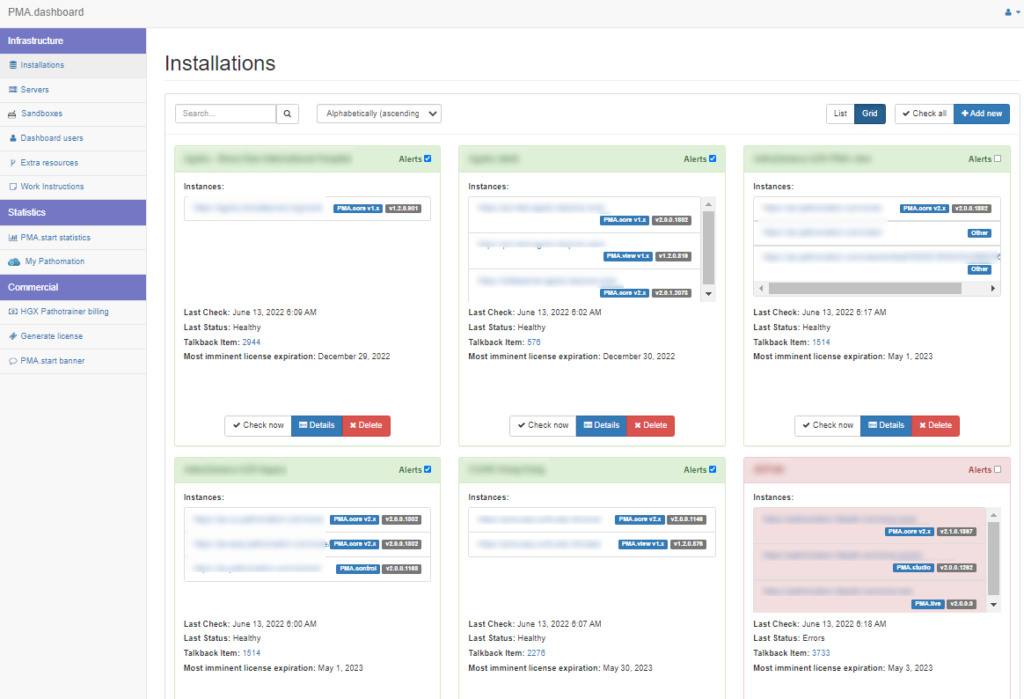
- A KPI is a KPI; we prefer knowledge. We’re lucky enough that we still have relatively short decision processes and everyone in the company understands what we’re doing. Because of this, we typically stay away from Google Analytics, because nobody gets anything out of a KPI.
- Scrum and Agile are full of rituals. If you want to perform rituals though, your calling may be in religion rather than technology. Not that we frown upon religious callings. We’re just saying there’s a difference. Stand-up meetings are a good example. For high-profile projects, we’ve found stand-up meetings to be extremely valuable. But when that (phase of the) project is over, there’s no need to keep the meeting schedule around anymore. If we did that, it would be the only thing we would do anymore.
- We look at standard methodologies as kitchen appliances; you use the ones you need when you need them. No need to institutionalize them. Some days you need a conventional oven; some days you need a microwave. There’s a reason they both exist. Chefs tell us that hybrid appliances that claim to do both, don’t really provide either functionality particularly well.
Does it work?
Sure, Pathomation is a small company, and we’re unconventional. Some call us rebels, renegades… Some partner with us exactly because of this even.
But of course, being rebellious cannot be a goal in itself; or even a merit.
What we’ve come to realize in the last year or so particularly is that products are only parts of the equation. What a company needs, in addition, to become successful is a set of processes.
The question then becomes: So does it work?
We think it does.
What it comes down to is that we do have a process that works now. Developers receive their input via Jira; managers can monitor respective projects through Jira dashboards. Build pipelines for different environments (no matter how diverse) are all organized through Jenkins. We’re on Microsoft Teams for meetings and chats, both at the office and at home. And for real-time technical support amongst the developers, there’s Slack.
Even though we use COTS software, we’ve still tuned it to match our own scale and pace. We still prefer on-premise installations instead of cloud, and we probably only have begun to scratch the surface of the possibilities in Jira (Confluence has recently been added to our arsenal).
There’s no right or wrong, or why you should follow our lead. Each company is different and should probably find what works for them. And realize that standardization can be a two-edged sword.
But even so: does it work? How do these processes in our case lead to better software?
We recently obtained our CE-IVD mark for PMA.core. So: yes.
But the tools and techniques described in this article don’t give the complete picture. So in a follow-up article, we plan to elaborate on what else was needed in addition to what we describe here, to get to yet another level of quality.


































